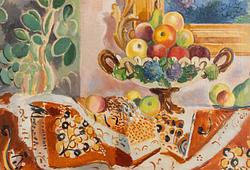Boet by Otto Schulz – A well kept design secret

Otto Schulz was a German-born designer and architect who worked most of his life in Gothenburg. His daring aesthetic has a multifaceted character and has contributed important elements to both the Swedish Grace and Swedish Modern eras. To pay tribute to the designer, we spoke to design historian Christian Björk, the author behind outstanding books on Swedish Grace, Swedish Modern and Axel Einar Hjorth, and now the author of a richly illustrated book of contemporary and historical imagery showing Otto Schulz's development over 4 decades.
”
The book about Schulz is a book that needed to be written. Writing about overexposed designers like Bruno Mathsson or Stig Lindberg is rather uninteresting. As a design historian, I want to broaden the understanding of the past through books about 20th-century oddities.
Christian Björk, design historian & writer behind ”Otto Schulz Möbler och inredningar 1910–1950”

Cabinet upholstered in blue leather with a geometric decoration of brass beaded nails and mahogany legs. Sold for a final price of 255 000 SEK.
Who was Otto Schulz?
“Otto Schulz Furniture and interiors 1910-1950” is a new book about the furniture designer and interior architect Otto Schulz who founded Firma Boet, Gothenburg’s most exclusive interior design store from 1920-1950. For many, he is still a hidden figure, but he really left an impression during his long professional life. He designed furniture and interiors for Gothenburg’s middle and upper class and could mix styles and expressions like few others. With an education in Berlin, he came to Sweden and Gothenburg at the beginning of the 20th century. At the time, there were few trained interior architects but many interior design assignments. Soon Schulz had decorated a large number of ships, restaurants and other public spaces. In 1920 he founded Firma Boet, roughly Gothenburg’s answer to Firma Svenskt Tenn in Stockholm, although Schulz’s style differed markedly from Josef Frank’s.
What made you interested, and why have you written a book about Otto Schulz?
I have written a few books about design, including one about Axel Einar Hjorth and the eras ”Swedish Grace” and ”Swedish Modern”. The book about Schulz is a book that needed to be written. Writing about overexposed designers like Bruno Mathsson or Stig Lindberg is rather uninteresting. As a design historian, I want to broaden the understanding of the past through books about 20th-century oddities. Erika Geiger Ohlin is the co-author, and Anders Nord did the book’s graphic design. Together we have made a richly illustrated book with contemporary and historical images showing Schulz’s development over 4 decades. The Röhsska Museum has an outstanding collection of watercolours by Schulz, a larger number of these watercolours, carefully selected from among the more than 1,600 watercolours in the museum’s collections, are reproduced in the book. All are searchable on the museum’s website. The watercolours are outstanding and executed over 3 decades, giving a unique insight into the period.

A Swedish Modern cabinet on stand by Boet, Gothenburg 1930-40s. Sold for a final price of 104 125 SEK.
What distinguishes Otto Schulz’s design language and choice of materials?
The book’s cover has motifs from the symbolic world of the Zodiac and is an example of Schulz’s creativity. He used the motif on both cabinets and tables, and through unexpected choices of materials and techniques, Schulz developed a design language that was sometimes peculiar and often striking. For some projects, baroque; for others, rococo; and for others, more sober and conservative modernism. Such disparate orders sometimes came to Schulz in the same week. That kind of style history was unusual under the strict and often so boring and anxious functionalism. As a progressive traditionalist and conservative functionalist, Schulz did not find a place in design history, which is explained in the book, which is 304 pages long with roughly 230 illustrations and thus the first about the design of Otto Schulz, Gothenburg’s most famous designer.


The cover of the book shows Otto Schulz's motifs from the symbolic world of the Zodiac – a prime example of Schulz’s creativity. Graphic design: Anders Nord.
Can you tell us something about Boet, the magazine, interior design, and furniture manufacturing company for which he is best known?
Otto Schulz was a furniture designer, interior architect, and entrepreneur but also a publicist and debater. His most important forum for debate was the magazine Boet – a monthly about home culture, craft, and art industry, which Schulz published in the years 1928–1938. It was one of Sweden’s most important in interior design, arts and crafts, furniture design and, not least, for international coverage. Most design critics wrote in the magazine during the 1930s, the magazine was filled with articles about Schulz’s design, but most articles were about colleagues such as Carl Malmsten, Alvar Aalto, Axel Einar Hjorth, Le Corbusier and others. Schulz was strategic; by publishing his furniture alongside the work of colleagues, he reasonably wanted to become part of this designer elite.
Why is Otto Schulz’s early 20th-century design so popular in interior design today?
His unique design language contributes enough, as does the quality of the execution. Anders Nord, the book’s graphic designer, sometimes says that all designs you recognize are already outdated, which is probably the case. A modernist and friend of matter of fact, anxious order may get deepened wrinkles of worry from Schulz’s idiom, but for those who have come further than that, Schulz’s idiom can be constantly surprising.

Cabinet, a pair, Boet, Gothenburg, Swedish Grace 1930s. Previously sold at Bukowskis for a final price of 477 750 SEK.

Watercolour showcasing Otto Schulz sports cabin furniture from the company Boet. Source: Röhsska museet, fotograf Carl Ander.
Is Otto Schulz the next Axel Einar Hjorth if you look at the prize image and international attention?
Axel Einar Hjorth has gone from forgotten to one of the 20th century’s most sought-after designers, all this in 10 years and long after his death. It is a very unusual development. The book about Hjorth was written almost 15 years ago and laid the foundation for knowledge about Hjorth’s design. It has been and will probably be the case in the future that Hjorth’s pine furniture continues to have an exceptional price picture. A unique design language, high demand and few pieces of furniture contribute to this. Most of Hjorth’s pine furniture has therefore been exported. The book about Otto Schulz ends with a section on sports cabin furniture from the company Boet. Today they are as unknown as Hjorth’s furniture once was. Schulz decorated many sports cabins during the late 1930s, mainly in western Sweden, and the future will tell if these will be as popular as Hjorth’s design.

#####Otto Schulz was a German-born designer and architect who worked most of his life in Gothenburg. His daring aesthetic has a multifaceted character and has contributed important elements to both the Swedish Grace and Swedish Modern eras. To pay tribute to the designer, we spoke to design historian Christian Björk, the author behind outstanding books on Swedish Grace, Swedish Modern and Axel Einar Hjorth, and now the author of a richly illustrated book of contemporary and historical imagery showing Otto Schulz's development over 4 decades.
Previous listings

Vasarahinta
390 000 SEK
Lähtöhinta
150 000 - 200 000 SEK

Vasarahinta
46 000 SEK
Lähtöhinta
50 000 - 75 000 SEK

Vasarahinta
85 000 SEK
Lähtöhinta
50 000 - 75 000 SEK

Vasarahinta
100 000 SEK
Lähtöhinta
50 000 - 75 000 SEK

Vasarahinta
160 000 SEK
Lähtöhinta
50 000 - 75 000 SEK

Vasarahinta
65 000 SEK
Lähtöhinta
40 000 - 60 000 SEK

Vasarahinta
48 000 SEK
Lähtöhinta
40 000 - 50 000 SEK

Vasarahinta
80 000 SEK
Lähtöhinta
25 000 - 30 000 SEK

Vasarahinta
60 000 SEK
Lähtöhinta
25 000 - 30 000 SEK

Vasarahinta
95 000 SEK
Lähtöhinta
20 000 - 25 000 SEK

Vasarahinta
44 000 SEK
Lähtöhinta
15 000 - 20 000 SEK

Vasarahinta
80 000 SEK
Lähtöhinta
12 000 - 15 000 SEK

Vasarahinta
22 000 SEK
Lähtöhinta
8 000 - 10 000 SEK























